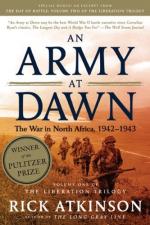
|
| Name: _________________________ | Period: ___________________ |
This test consists of 15 multiple choice questions and 5 short answer questions.
Multiple Choice Questions
1. What did Allen determine to do instead of following Colonel Greer's suggestion?
(a) Bifurcate the city with tanks and take the high ground first.
(b) Bypass St. Cloud.
(c) Use air support and cover of night to take out specific enemy installations.
(d) Concentrate his troops and make one desperate last push.
2. What was the biggest deficiency, according to the author, in Allied planning?
(a) Artillery.
(b) Transportation.
(c) Lack of air fields.
(d) Morale.
3. The radio messages "batter up" and "play ball" meant what to the American fleet?
(a) Troops are landed and on the offensive.
(b) Air superiority was achieved and the landing could be made.
(c) Casablanca has been taken and forces are now to move East.
(d) Acknowledged French resistance and authorized retaliatory fire.
4. Does the author consider RESERVIST a success?
(a) No, although it was claimed as such.
(b) No, with the exception that not a single Allied ship was lost.
(c) Yes, especially in that no ships in the harbor were scuttled or damaged by the battle.
(d) Yes, despite heavy casualties.
5. Hitler reinforced Tunis because of what realization, according to the author?
(a) That the American claim to plan a landing on the shores of Normandy was a rouse.
(b) That North Africa could be used as a platform for the invasion of southern Europe.
(c) That the Vichy French alliance had collapsed.
(d) That Italy would not be able to adequately face the size of the Allied force there.
6. What became the unofficial motto of Allied forces in Tunisia?
(a) "It flies, it dies."
(b) "To the last of our rations."
(c) "Kilroy was here."
(d) "Dig or Die."
7. According to the author, what significant change occurred in the relationship between the Allies over the course of the campaign?
(a) Britain slipped into the role of a junior partner to America.
(b) Vichy France betrayed their agreement with Germany by refusing to fight Americans.
(c) Italy sided with the Allies.
(d) America formed an immediate bond with Britain.
8. The General Lee is described by the author as: "double the Stuart's weight, with a 75mm gun in the hull, a 35mm squirrel rifle in the turret, and four machine guns." What did the author describe as it's flaws?
(a) Too wide for city streets, poor at sand travel and expensive.
(b) Height, the large gun could traverse only a couple degrees and was set too low.
(c) Terrible range, accuracy and weakness from behind.
(d) Lack of forward armor, speed and maneuverability.
9. What political arrangement with the French particularly caused a public outcry in both the U.S. and Britain?
(a) Giraud's promotion to Commander-in-Chief.
(b) The Darlan deal.
(c) Supply of French.
(d) Amnesty for Petain.
10. What two issues particularly occupied the minds of the American strategists planning Torch?
(a) The training of troops on two different continents and how to merge the forces while at sea.
(b) German U-boats and Japanese dive bombers.
(c) That minimal British troops accompany the initial landings and where to make the landings.
(d) If the plan had been leaked to the Germans and Vichy France's certain role in fighting the landings.
11. The average number of deaths per day during the war averaged:
(a) 12,600.
(b) 27,600.
(c) 9,600.
(d) 7,600.
12. The shortages of necessities at the outset of Anderson's push East, inspired this quote: "The most important thing is never to be apart from your:
(a) Rations.
(b) Radio.
(c) Spoon.
(d) Unit.
13. What was the plan for integrating U.S. units into British lead military organizations?
(a) New U.S. troops were sent to England for specialist training.
(b) No plan existed.
(c) Units would be on a four week rotation.
(d) Select troops were permanently assigned.
14. What kind of memorial fills the American military cemetery at Carthage to mark the graves of American troops?
(a) Simple marble markers.
(b) Catacombs.
(c) Several granite obelisks.
(d) One large marble tomb.
15. What was operation WATCHTOWER?
(a) The first Allied counter-offensive against Japan at Guadalcanal.
(b) A pre-emptive strike by the Royal Air Force against North African Axis bases.
(c) The name of the original U.S. plan to attack Germany through France.
(d) A covert mission to convince Vichy France to join the Allied cause.
Short Answer Questions
1. America declared war on Germany upon:
2. According to the author, North Africa is where the Axis forever lost:
3. The signal "Advance Napoleon," was issues by Eisenhower which indicated what to the troops readying operation VILLAIN?
4. North Africa is where the Allies agreed on a policy of:
5. Who did the American contingent meet in Cherchel?
|
This section contains 846 words (approx. 3 pages at 300 words per page) |

|




